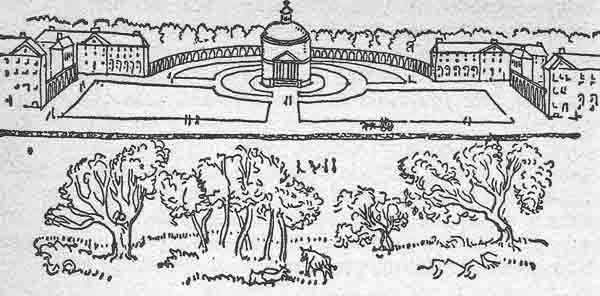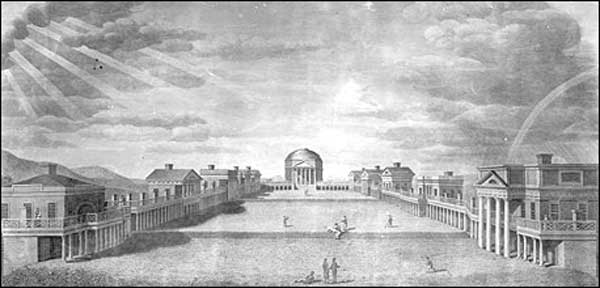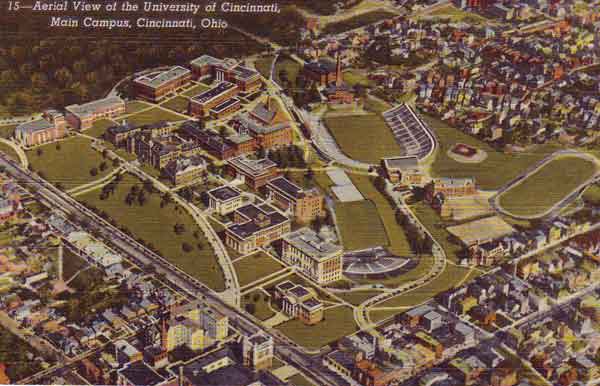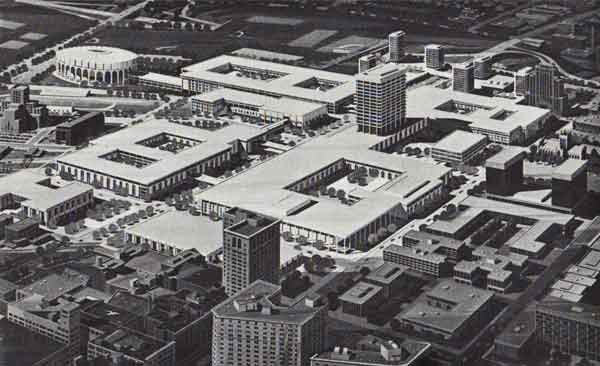

225 the college campus
The college campus, though perhaps European in origin, reached its fullest development in the U.S.—so much so, that it has become not merely a commonplace of our design, but a true symbol of American life. Architect William Wilkins gets credit for the first of them, Downing College at Cambridge (1806), an arrangement of Neoclassical buildings around a green. The idea must have been in the air. Just a year later, South Carolina College at Columbia (now the University of South Carolina) began its new campus with a grouping of buildings still called the 'Horseshoe' today. Pictured above is a sketch of Joseph Ramée's plan for Union College in Schenectady, New York (1813). Ramée was a remarkable character, a cosmopolitan architect who worked in many countries besides his native France; he knew everyone worth knowing in his day, from Goethe to William Beckford. Union College, like many of the new American schools,was founded as a new, democratic kind of institution, one open to everyone of talent. The old universities had been enclosed in quadrangles since the Middle Ages; now, Ramée found a way to express in design the ideals of a very different age. 
Among those who noticed the innovations in Columbia and Schenectady was Thomas Jefferson. Four years later, the former president produced the famous design for the 'academical village' of his new foundation, the University of Virginia at Charlottesville. The somewhat idealized view in this old print shows the Enlightenment orderliness of Jefferson's concept, as well as the architectural device that ties it together: the colonnade that connects the buildings, tying them into a unified composition as well as keeping students and professors out of the rain. And nothing could be more Jeffersonian than the blunt symbolism of the Rotunda, the ensemble's centrepiece—not a church, but .a secular building devoted to knowledge alone. 
The first campuses, built during the classical revivals, had been very conscious examples of formal design, and as new institutions sprouted up all over America, that tradition continued—as at Duke (1892), where medieval Gothic buildings were somewhat uncomfortably pressed into a symmetrical, formal plan, or Stanford, where Frederick Law Olmsted (among others) designed a formal campus with architecture that came out in an odd sort of recycled California Mission. More often, though, the campus idea meant simply an oasis of greenery in an urban setting, with buildings placed wherever successive generations of regents and architects thought they might best fit. Buildings would grow up around an open space, and the whole would often be called a 'quadrangle'. It was, in fact, a perfect opportunity for a revival of informal design, with few constraints on the siting of buildings. But it never really blossomed; the informal tradition had been lost completely. Almost every campus in the nation, from Harvard's to Boise State's, has the impression of being thrown together haphazardly-because they were. In the postwar decades, many campuses commenced grandiose expansion programs, often following the modernist cliché of superblocks in geometrical arrays. Each decade's work was worse than the last. 
In the 70's campus design and architecture hit rock bottom. Here is the original plan for Cleveland State University, 1964. Sited on the fringes of downtown, the new university was conceived as an isolated compound —not much greenery, but plenty of lovely blank walls; the actual architecture came out even grimmer than this planners' drawing. Their construction necessitated the demolition of some fine buildings along Euclid Avenue and several streets of decent apartments; somehow, almost miraculously, the planners brought 15,000 students to the city center and made the area more dead than it had been before they came. If this is its logical conclusion, Americans might ask themselves whether the campus was really such a clever idea in the first place. The idea of separating the business of learning from the other activities of the city—giving the scholars a bit of tranquillity, and the inspiration of nature—had seemed innocent enough. By the 1890's we were expanding the campus idea to the creation of entire 'cultural districts', subtracting everything pleasant and uplifting from the squalid hurly-burly of our towns. Later on, businesses would be hauling their employees out to isolated suburban office compounds, and they called these 'campuses' too, while urban universities and cultural districts, if they bordered less desirable neighbourhoods, were buying up vast amounts of land on their borders (usually with public funds) and bulldozing it to create a safe perimeter. In the end, the campus turns into a fortress. |
|

|